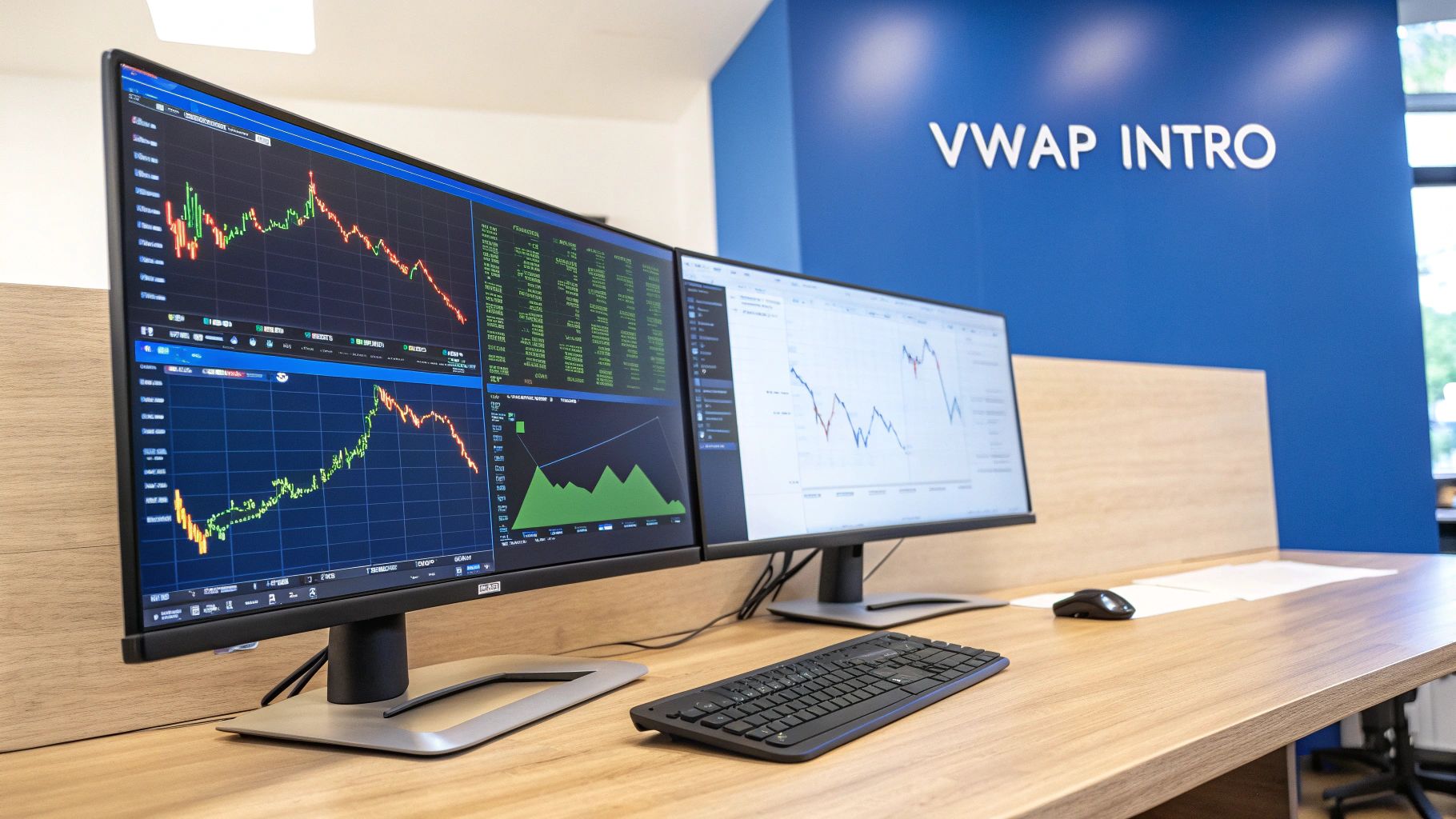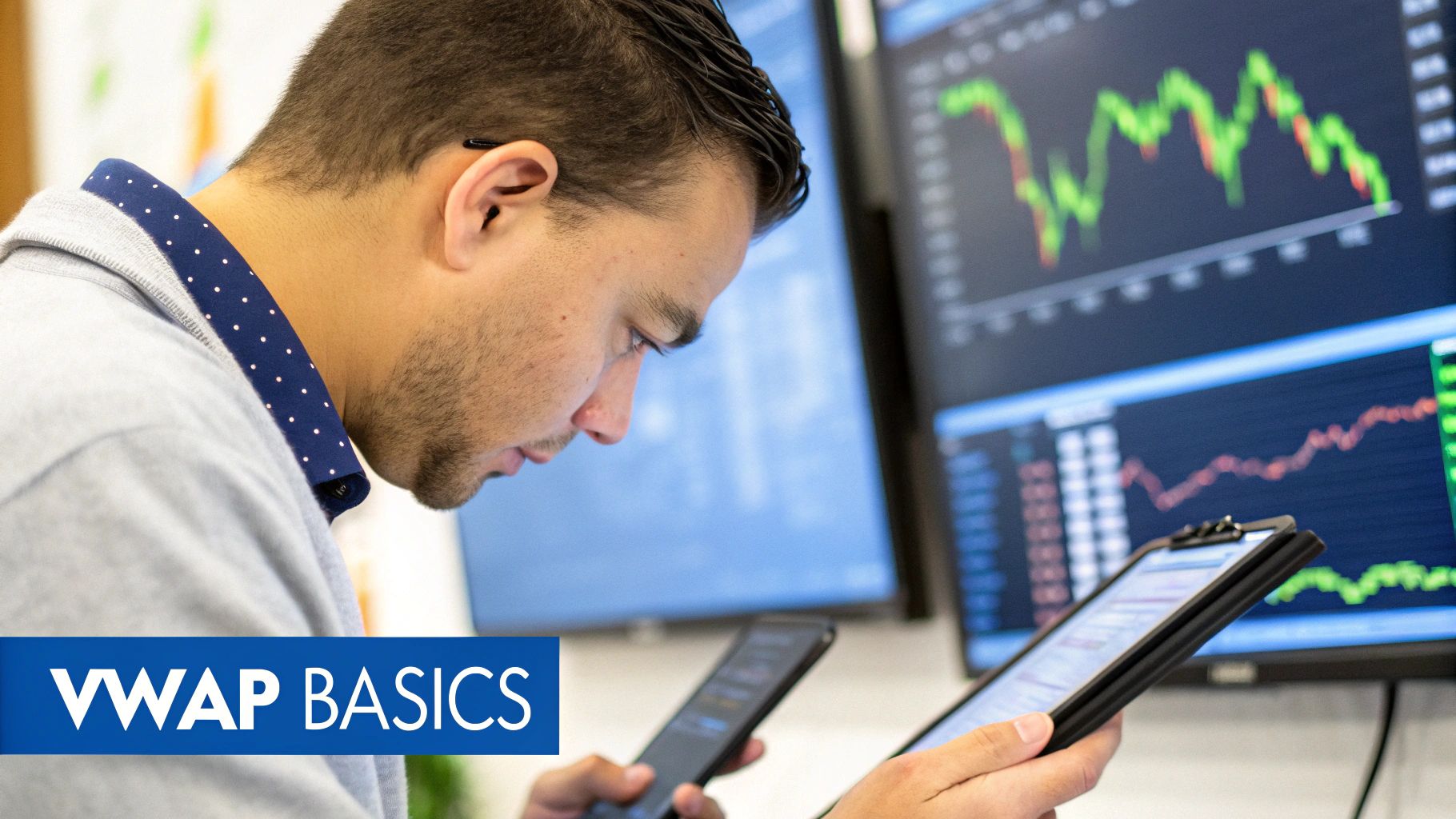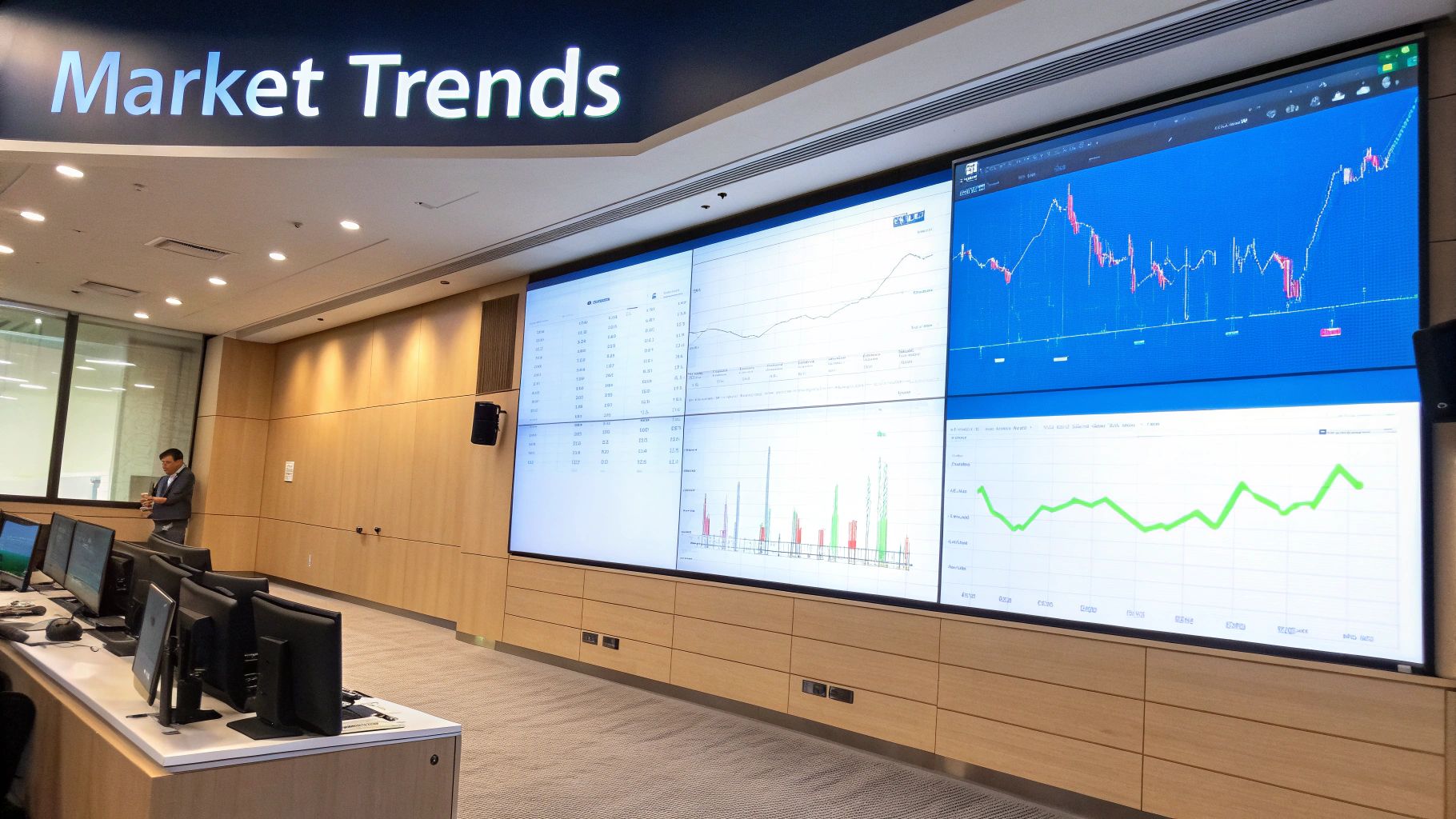VWAP Trading Strategy: Expert Techniques for Profit
Decoding VWAP: The Smart Trader's Secret Weapon

Successful stock market trading requires a strategic approach, not just intuition. The Volume Weighted Average Price (VWAP) is a key element of this strategy. VWAP is more than just a metric; it's become essential for many successful trading strategies. It provides valuable market insights by considering both price and volume, giving traders an edge.
Unlike simple moving averages, VWAP emphasizes the average price weighted by trading volume. This reveals the actual price points where large institutional players are concentrating their efforts. Traders can align themselves with this "smart money" momentum.
Understanding the Power of VWAP
VWAP acts as a real-time indicator of market sentiment. When the price trades above the VWAP, it typically suggests bullish sentiment. Conversely, trading below the VWAP often signals bearish sentiment.
This clear visual representation lets traders quickly assess the prevailing market direction. They can then make more informed decisions. VWAP can also help identify potential support and resistance levels, improving the ability to anticipate price movements. High-volume trading around the VWAP often establishes these strong support or resistance zones.
Combining VWAP with other technical indicators can confirm potential trade setups. For instance, a bullish candlestick pattern forming near the VWAP, combined with a break above the VWAP line, could indicate a strong long entry.
The effectiveness of VWAP isn't just anecdotal. A study demonstrated the profitability of a VWAP-based day trading strategy applied to QQQ and TQQQ from January 2, 2018, to September 28, 2023. A $25,000 investment generated a 671% return with a Sharpe Ratio of 2.1. This significantly outperformed a passive buy-and-hold strategy. Learn more here.
Integrating VWAP Into Your Trading Arsenal
VWAP is a powerful tool within a broader trading strategy, not a standalone solution. Top traders combine VWAP with other indicators and risk management techniques. This maximizes their effectiveness.
VWAP can be incorporated into various trading styles, from scalping to swing trading. The key is understanding how VWAP interacts with other indicators. It also helps in using VWAP to confirm or refute potential trading signals.
VWAP: More Than Just an Indicator
VWAP provides more than just entry and exit signals. It offers insights into market psychology. By observing price action relative to the VWAP, traders can gauge institutional sentiment and conviction.
Specific VWAP relationships can signal strong directional bias. Others may warn of impending reversals. This understanding of market dynamics helps traders anticipate potential momentum shifts. They can then adjust their strategies. Mastering VWAP can be a game-changer for traders seeking a competitive edge.
Day Trading With VWAP: Strategies That Actually Work

Let's dive into the practical applications of VWAP (Volume Weighted Average Price) in day trading. We'll explore how professional traders use VWAP in real-world market scenarios to identify profitable setups. These strategies range from momentum-based plays using VWAP crosses to mean-reversion strategies focusing on VWAP rejections.
VWAP Crossover Strategies
A popular VWAP trading strategy revolves around crossovers. When the price crosses above the VWAP, it can be a bullish entry signal. A cross below the VWAP may indicate a bearish entry.
However, blindly trading every crossover can be a risky endeavor. Experienced traders often use additional filters to improve signal accuracy. These filters might include confirming candlestick patterns or looking for volume spikes. For instance, a bullish engulfing candlestick pattern coinciding with a price crossing above the VWAP could present a strong long entry.
VWAP Mean Reversion Strategies
VWAP also plays a role in mean-reversion strategies. The core concept here is that price tends to gravitate back towards the VWAP after significant deviations. When the price moves substantially above or below the VWAP, it could create an opportunity to trade the reversion.
If the price significantly surpasses the VWAP, a trader might look for short entry opportunities, anticipating a price drop back towards the VWAP. VWAP standard deviation bands can further help identify extreme price deviations and potential reversal zones.
Adapting VWAP Strategies Throughout the Trading Day
The effectiveness of various VWAP patterns can change throughout the trading session. Some patterns may be more reliable during the opening bell, while others perform better during midday or closing sessions. Adapting your approach throughout the day is crucial.
VWAP crossover strategies might be more effective during volatile periods, whereas mean-reversion strategies might be better suited for calmer markets. This flexibility helps traders stay in sync with current market dynamics. VWAP isn't just for day trading; it's also vital for minimizing market impact when executing large orders. In algorithmic trading, VWAP helps break down large trades into smaller chunks, minimizing price disruptions. Learn more about VWAP algorithms.
Utilizing VWAP Standard Deviation Bands
Advanced traders use VWAP standard deviation bands to identify potential price extremes. These bands are plotted a specific number of standard deviations above and below the VWAP. When the price reaches the outer bands, it may indicate overbought or oversold conditions, suggesting potential reversals. For example, a price touching the upper standard deviation band could signal a short entry opportunity.
Combining standard deviation bands with other VWAP techniques provides a robust framework for identifying high-probability entries and exits. This enhances the precision timing of trades. This combination allows day traders to effectively navigate changing market conditions throughout the trading day, potentially increasing their success rate.
To help illustrate the different VWAP trading approaches, let's take a look at the following comparison:
VWAP Trading Strategy Comparison This table compares different VWAP trading approaches based on market conditions, timeframes, and effectiveness.
| Strategy Type | Best Market Conditions | Typical Timeframe | Win Rate Potential | Risk Level |
|---|---|---|---|---|
| VWAP Crossover | Trending markets with moderate volatility | Short-term (intraday) | Moderate to High (with confirmation) | Medium |
| VWAP Mean Reversion | Range-bound or consolidating markets | Short-term to medium-term | Moderate | Medium to Low |
| VWAP with Standard Deviation Bands | Volatile markets or periods of extreme price movement | Short-term (intraday) | Moderate to High (with confirmation) | Medium to High |
As you can see, each strategy type excels under different market conditions and carries varying levels of risk. Crossover strategies shine in trending markets, mean reversion in consolidating markets, and using standard deviation bands can be particularly insightful during volatile periods. Traders should carefully consider their risk tolerance and trading style when selecting a VWAP strategy.
Reading Market Psychology Through VWAP Patterns

VWAP, or Volume Weighted Average Price, offers traders more than just simple entry and exit points. It provides valuable insights into the overall market psychology. By analyzing how price interacts with the VWAP, experienced traders can get a sense of institutional sentiment and conviction.
This understanding can help anticipate potential market shifts and align trades with what is often referred to as "smart money."
Identifying Directional Bias and Reversals
Specific VWAP relationships can strongly suggest a directional bias in the market. For example, sustained price action above the VWAP often indicates bullish sentiment. Conversely, consistent trading below the VWAP can suggest bearishness.
It's important to remember that these interpretations should be considered within the larger market context and aren't foolproof indicators on their own.
VWAP can also help traders anticipate potential reversals. A divergence between price and VWAP, where price rises while VWAP falls (or vice-versa), can act as a warning signal. This disconnect often precedes changes in trends, offering valuable clues for proactive traders.
The VWAP indicator has broader applications beyond day trading. It can be used to understand overall market trends and sentiment. When the price is above the VWAP, it generally suggests bullish sentiment, while being below suggests bearish sentiment. This can be helpful in identifying potential support and resistance levels. Traders often use VWAP to try to align their trades with institutional players, often referred to as "smart money." Learn more about VWAP. Additionally, VWAP divergence, where price action and VWAP move in opposite directions, can signal potential trend reversals.
Unveiling Accumulation and Distribution
Observing price action around the VWAP can also reveal instances of institutional accumulation and distribution. Significant volume clusters near the VWAP, particularly when combined with certain candlestick patterns, can indicate large players accumulating or distributing positions. This type of information is often overlooked by retail traders who primarily focus on price.
For instance, a high-volume bounce off the VWAP, combined with a bullish reversal candlestick pattern, could suggest institutional buying. Conversely, a high-volume rejection at the VWAP, along with a bearish candlestick pattern, might indicate institutional selling pressure.
VWAP as Dynamic Support and Resistance
VWAP isn't a static line. It acts as dynamic support and resistance. As the trading day progresses, the VWAP changes, creating new zones of potential support and resistance. These VWAP levels often become important areas for price action, providing traders with potential entry and exit points.
Understanding how price reacts to these constantly evolving VWAP levels can improve the precision of trade entries and exits. This potentially allows traders to capitalize on short-term market fluctuations and optimize their risk-reward ratios. By combining VWAP with other indicators, traders can develop a comprehensive system for analyzing market sentiment. This can empower them to make more informed decisions based on institutional capital flow.
Advanced VWAP Techniques The Pros Don't Share

Moving beyond basic VWAP crossover and mean reversion strategies opens a world of advanced techniques that can significantly improve your trading. These techniques, often used by institutional traders, offer a deeper understanding of market dynamics and unique trading opportunities.
Anchored VWAP: Unveiling Hidden Support and Resistance
One such technique is the Anchored VWAP. This method anchors the VWAP calculation to a significant market event. Think of events like a major high or low, a breakout point, or the beginning of a new trend, rather than the typical session start. This offers valuable insight into how the market is performing relative to that specific event.
Anchored VWAP can reveal hidden support and resistance levels. These levels can influence market behavior for extended periods, sometimes even weeks or months. For example, anchoring to a major market bottom might reveal key levels where substantial buying pressure could reappear.
You might be interested in: How to master supply and demand zone trading techniques.
Layering Multiple VWAP Timeframes: Identifying Confluence Zones
Another powerful technique involves layering multiple VWAP timeframes on a single chart. This helps traders spot confluence zones, where VWAPs from different timeframes intersect. These zones often act as strong support or resistance areas, providing trading setups with potentially good risk-reward possibilities.
Imagine the convergence of daily, weekly, and monthly VWAPs. This could indicate a significant support zone, potentially ideal for a long entry.
Combining VWAP with Volume Profile: A Three-Dimensional Market View
Using VWAP with volume profile adds another dimension to market analysis. Volume profile shows trading volume distribution at various price levels, highlighting high and low volume areas. Combined with VWAP, this provides insights into institutional accumulation and distribution patterns.
These patterns are often unseen by those focusing solely on price action. This combination allows for a more complete understanding of market structure and helps identify potential turning points. Quantitative equity portfolio management frequently uses techniques like VWAP because of its ability to analyze both volume and price. This approach provides a deeper understanding of market dynamics compared to basic moving averages, contributing to robust trading systems. Learn more about quantitative equity investing.
Adaptive VWAP Strategies: Adjusting to Changing Volatility
Finally, many professional traders utilize adaptive VWAP strategies. These strategies adjust to changing market volatility and conditions. Instead of fixed parameters, adaptive VWAP strategies dynamically adjust their settings based on current market volatility. This allows traders to refine their approach and improve performance across different markets and conditions. For example, during periods of high volatility, traders might widen their VWAP bands to accommodate larger price swings. This flexibility is essential for consistent success in the dynamic stock market.
Validating Your VWAP Strategy: Beyond Simple Backtesting
Building a solid VWAP trading strategy takes more than just a basic backtest. Experienced traders utilize advanced methods to confirm their VWAP approaches, ensuring they account for real-world market dynamics. This involves looking past simple win rates and focusing on metrics that truly demonstrate a strategy's resilience.
Why Most Backtests Fail
Many backtests come up short because they fail to accurately replicate actual trading scenarios. They frequently overlook vital aspects such as slippage (the difference between the expected price of a trade and the price at which the trade is actually executed), commission costs, and market liquidity limitations. Overlooking these elements can result in excessively optimistic outcomes that don't translate to live trading. For example, a backtest might indicate a high win rate, but failing to account for slippage could drastically reduce actual profits.
Creating a Realistic Testing Environment
For a backtest to be trustworthy, you must incorporate realistic slippage and commission models. Furthermore, your testing environment needs to account for market liquidity. This means considering how easy or difficult it would be to execute your desired trade size at your target price. This is particularly important for VWAP trading strategies, which often involve trading during periods of high volume.
Check out our guide on How to backtest a trading strategy for a deeper look at this crucial process.
Establishing Meaningful Performance Metrics
Go beyond simply looking at win rates. Instead, focus on key metrics like the Sharpe Ratio, maximum drawdown, and profit factor. The Sharpe Ratio evaluates risk-adjusted return, providing a clearer picture of performance relative to volatility. Maximum drawdown shows the greatest peak-to-trough decline during the testing period, helping you assess potential downside risk. The profit factor compares gross profits to gross losses, offering insight into the overall profitability of your strategy. For instance, a Sharpe Ratio of 2.0 or higher is generally considered an excellent indicator.
Analyzing Successful and Failed Strategies
Review both your winning and losing trades to find recurring patterns and pinpoint areas for improvement. Understanding the reasons behind specific trade outcomes provides invaluable insight into your VWAP trading strategy's strengths and weaknesses. This analysis allows you to fine-tune your approach and improve your chances of long-term success.
To better understand how to measure the performance of your VWAP strategy, take a look at the table below. It outlines essential performance metrics, their meaning, ideal target ranges, and potential warning signs to watch out for.
VWAP Strategy Performance Metrics
| Performance Metric | Explanation | Target Range | Warning Signs |
|---|---|---|---|
| Win Rate | Percentage of winning trades | Not solely reliant on this | High win rate with low average profit |
| Sharpe Ratio | Risk-adjusted return | > 1.0 (good), > 2.0 (excellent) | < 1.0 |
| Maximum Drawdown | Largest peak-to-trough decline | As low as possible | > 20% (consider risk tolerance) |
| Profit Factor | Gross profit / Gross loss | > 1.5 | < 1.0 |
As this table demonstrates, relying solely on the win rate can be misleading. A high win rate coupled with low average profit per trade can still result in poor overall performance. Focusing on a combination of metrics provides a more complete evaluation of your VWAP strategy.
Transitioning to Live Trading
When you're ready to transition from simulated trading to live trading, begin with a smaller account size. Gradually increase your position size as your confidence and experience grow. Implement robust risk management practices, like setting stop-loss orders, to protect your capital. This careful approach will help you adapt to live market conditions and accumulate practical experience without exposing yourself to excessive risk.
VWAP Trading Pitfalls: Learn From Others' Expensive Mistakes
Even seasoned traders can make costly errors when using VWAP (Volume Weighted Average Price) strategies. By examining common mistakes, we can learn valuable lessons and improve our own trading approaches. This includes understanding why simply chasing every VWAP cross can lead to significant losses and how successful traders use filters to avoid low-probability setups.
The Danger of Blindly Following VWAP Crosses
One of the most common pitfalls is blindly trading every VWAP cross. While crossing above the VWAP can signal a potential buying opportunity, and a cross below can signal a selling opportunity, these signals alone are not enough. The market is complex, and numerous factors can influence price action.
Imagine relying solely on VWAP crosses in a choppy market. The constant back-and-forth price action will generate numerous false signals, leading to whipsaws and losses. Successful traders avoid this by using additional filters to confirm the validity of the signal.
These filters might include:
- Candlestick patterns
- Volume indicators
- Other technical analysis tools
This approach helps separate genuine signals from market noise. When considering potential pitfalls, remember to validate your strategy, including examining effective load testing strategies.
Context Is King: Considering Broader Market Conditions
Another common mistake is ignoring broader market conditions. VWAP signals should always be interpreted within the larger context of the market. A VWAP crossover might seem bullish in isolation, but if the overall market is bearish, the likelihood of a sustained uptrend is much lower.
For example, a bullish VWAP crossover during a market-wide sell-off might be a temporary blip rather than a genuine reversal. Successful traders consider market sentiment, economic news, and other relevant factors before entering a trade. This broader understanding allows them to better assess the probability of success.
Adapting to Changing Volatility: A Key to Consistent Success
Many traders fail to adapt their VWAP strategy to changing volatility environments. A VWAP strategy optimized for low volatility might perform poorly during periods of high volatility, and vice versa. This inflexibility can undermine otherwise sound trading methods.
During high volatility, prices tend to fluctuate more dramatically, causing wider swings around the VWAP. This makes it harder to determine precise entry and exit points, potentially leading to larger losses than anticipated.
Learning From Failed VWAP Campaigns: Extracting Valuable Lessons
Analyzing failed VWAP trading campaigns is crucial for improvement. By carefully examining past mistakes, we can identify recurring patterns and refine our approach. These experiences can range from overreliance on a single indicator to neglecting risk management principles.
Analyzing past trades helps you understand why certain trades went wrong. This retrospective analysis can reveal weaknesses in your strategy and help you refine your approach. By analyzing past trades and identifying patterns, you can transform failed campaigns into valuable learning experiences. This process of continuous improvement is essential for long-term trading success.
Ready to enhance your trading with powerful charting and analysis tools? Explore ChartsWatcher, a sophisticated platform designed for professional traders, and unlock the potential of real-time data and customizable dashboards.

